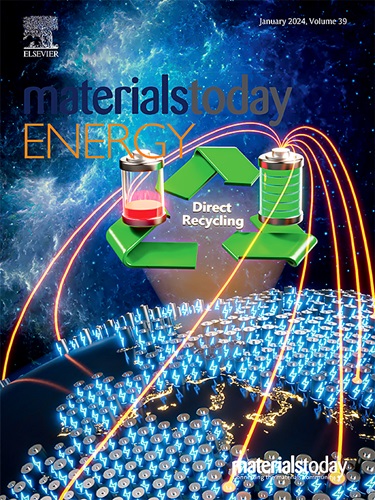Investigation of Mn incorporation into NiOOH electrocatalyst loaded on BiVO4 photoanode for enhanced photoelectrochemical water splitting: Experimental and theoretical approach
IF 8.6
2区 材料科学
Q1 CHEMISTRY, PHYSICAL
引用次数: 0
Abstract
Loading of OER cocatalyst is an effective strategy to overcome the inherent poor charge separation of BiVO. Incorporation of Mn-doped NiOOH electrocatalyst on the electrochemically deposited BiVO photoanode surface boost the PEC water oxidation. Here, the Mn-NiOOH/BiVO (10%) photoanode exhibited ∼2.6 and ∼1.7-fold higher photocurrent density (2.41 mA cm), compared with BiVO and BiVO/NiOOH, respectively. Noticeably, it delivered the transient decay time (τ) of 1.83 s, which is ∼3.5 and ∼2.3-fold higher than the BiVO and BiVO/NiOOH, besides the BiVO/Mn-NiOOH (10%) utilizes 42.4 % of the photogenerated holes, whereas in BiVO, it is only 17.06 %, and BiVO/NiOOH exhibits 25.98 % for the water oxidation process. The enhanced PEC activity of the BiVO/Mn-NiOOH photoanode is due to reduced photoinduced charge carrier’s recombination rate, facile interfacial charge transfer, and rapid hole consumption. Moreover, the higher efficiency of Mn-NiOOH cocatalyst is understood by employing DFT studies and revealed that Mn-NiOOH (10%) has lower formation energy than higher concentrations and infers that it requires the lower overpotential (2.37 V) than NiOOH (3.06 V). Overall, under illumination, Mn-NiOOH consumes the photogenerated holes from BiVO for the cyclic catalytic process of NiOOH, thus enhances the PEC performance.在 BiVO4 光阳极上负载的 NiOOH 电催化剂中加入锰以增强光电化学水分离的研究:实验和理论方法
添加 OER 助催化剂是克服 BiVO 固有的电荷分离不良问题的有效策略。在电化学沉积的 BiVO 光阳极表面加入掺杂锰的 NiOOH 电催化剂可促进 PEC 水氧化。与 BiVO 和 BiVO/NiOOH 相比,Mn-NiOOH/BiVO(10%)光阳极的光电流密度(2.41 mA cm)分别高出 2.6 倍和 1.7 倍。值得注意的是,它的瞬态衰减时间(τ)为 1.83 秒,比 BiVO 和 BiVO/NiOOH 分别高出 3.5 倍和 2.3 倍。此外,BiVO/Mn-NiOOH(10%)利用了 42.4% 的光生空穴,而 BiVO 仅利用了 17.06%,BiVO/NiOOH 在水氧化过程中利用了 25.98%。BiVO/Mn-NiOOH 光阳极的 PEC 活性增强是由于光诱导电荷载流子的重组率降低、界面电荷转移容易以及空穴消耗快。此外,Mn-NiOOH 助催化剂的效率更高,这要归功于 DFT 研究,研究表明 Mn-NiOOH(10%)的形成能低于更高浓度的 Mn-NiOOH,并推断出它所需的过电位(2.37 V)低于 NiOOH(3.06 V)。总之,在光照下,Mn-NiOOH 消耗 BiVO 光生空穴,用于 NiOOH 的循环催化过程,从而提高了 PEC 性能。
本文章由计算机程序翻译,如有差异,请以英文原文为准。
求助全文
约1分钟内获得全文
求助全文
来源期刊

Materials Today Energy
Materials Science-Materials Science (miscellaneous)
CiteScore
15.10
自引率
7.50%
发文量
291
审稿时长
15 days
期刊介绍:
Materials Today Energy is a multi-disciplinary, rapid-publication journal focused on all aspects of materials for energy.
Materials Today Energy provides a forum for the discussion of high quality research that is helping define the inclusive, growing field of energy materials.
Part of the Materials Today family, Materials Today Energy offers authors rigorous peer review, rapid decisions, and high visibility. The editors welcome comprehensive articles, short communications and reviews on both theoretical and experimental work in relation to energy harvesting, conversion, storage and distribution, on topics including but not limited to:
-Solar energy conversion
-Hydrogen generation
-Photocatalysis
-Thermoelectric materials and devices
-Materials for nuclear energy applications
-Materials for Energy Storage
-Environment protection
-Sustainable and green materials
 求助内容:
求助内容: 应助结果提醒方式:
应助结果提醒方式:


